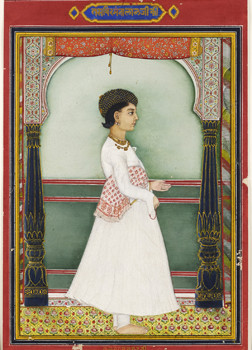Faces and Facets at PU Art Museum Showcases Recent Acquisitions


INDIAN MINIATURE: Mana Lalji, ca. 1860, paque watercolor and gilt on paper, 13 7/8 x 9 7/16 inches was purchased by the Princeton University Art Museum from the Fowler McCormick, Class of 1921, Fund and is part of an eclectic summer exhibition there through August 18. For more information call (609) 258-3767 or visit: www.artmuseum.princeton.edu.
This summer, the Princeton University Art Museum will offer visitors a smorgasbord of tasty morsels by way of a special installation designed to highlight the range and depth of its collections.
Faces and Facets, a multifaceted show featuring 50 works acquired since 2010, underscores the Museum’s position among the leading university art museums in the country. Since it was founded in 1882 with a gift of porcelain and pottery, the Museum has grown to include over 80,000 works of ancient to contemporary art of the Mediterranean regions, Western Europe, China, the United States, and Latin America.
Exhibition curator Juliana Dweck, Andrew W. Mellon Curatorial Fellow for Collections Engagement, faced quite a challenge when the Art Museum decided to put a selection of recent acquisitions on display. The eclectic grouping could have been arranged in any number of ways. In the beginning, the task of handling what seemed like a rather ungainly grouping, became manageable when she decided on a thematic grouping, after soliciting suggestions from her fellow museum curators.
“This exhibition is unusual in that it displays items across a broad range of materials, media, periods, styles, and cultures and it provides a rare opportunity to juxtapose an intentionally eclectic selection,” said Ms. Dweck who has been with the museum for three years and a Mellon Curatorial Fellow for less than two. Although she has managed the interpretations of several exhibitions, this is her curatorial debut.
The exhibition is arranged in four thematic sections and takes its name from the first of these: “Faces and Facets,” which traces the varying ways that “portraits” — whether of a person or an object — both shape and are shaped by the viewer’s understanding of the world. In addition to famous faces like Thomas Edison and Marlene Dietrich, this section, says the curator examines, for example, portraits of a bird and of a building.
The “Symmetry” section plays with the idea of how balance, regularity, and repetition can offer pleasing compositions or suggest the opposite — asymmetry and disorder — to achieve a particular effect. Here are examples of graphic patterns as well as textiles and ceramics.
The section titled “Assemblage” examines how the elements of a work of art can be just as meaningful as the overall configuration. It looks at collage-style items as well as spatial arrangements and images such as one that shows a network of roads in California. Another section, “Revealing and Concealing,” ponders the way in which narratives, visual layers, and data are either encoded (concealed) or exposed (revealed) in works of art. That is to say, explains Ms. Dweck, “it looks at the way art reveals and conceals the truth.
Asked to select a personal favorite, Ms. Dweck says that her favorites vary from day to day. “Today, perhaps because I’ve been spending time with it, it’s most definitely the Chimu Textile, a fragment from Peru circa 1200 A.D. that depicts a procession of prisoners. It is thought to be a record of an historical event and it’s not only historically significant it is very appealing graphically,” she says, adding “one of my other favorites is the 19th century Indian watercolor of Mana Lalji showing him in profile and wearing gold necklaces and holding prayer beads.”

THE OLD MASTER REVEALED: “Self Portrait with Plumed Cap and Lowered Sabre, 1634,” etching and drypoint, 5x 4½ inches by Rembrandt van Rijn (1606–1669) was given to the Princeton University by Thomas F. and Ada Deuel and is part of an eclectic summer exhibition of recent acquisitions on view at the Princeton University Art Museum through August 18. Admission is free and hours are Tuesday, Wednesday, Friday, and Saturday 10 a.m. to 5 p.m.; Thursday 10 a.m. to 10 p.m.; and Sunday 1 to 5 p.m. The Museum is closed Mondays and major holidays. For more information call (609) 258-3767 or visit: www.artmuseum.princeton.edu.
The works on display represent a small selection of the hundreds of gifts and purchases that have recently been added to the Museum’s holdings. They include major works by Rembrandt, Robert Smithson, Kurt Schwitters, Hannah Wilke, and many other artists including Jules Olitski, Philip Pearlstein, Bridget Riley, Florian Schmidt, John Trumbull, and Hale Woodruff. The exhibition features Greek, Japanese, and Native American ceramics; ancient Cypriot and Pre-Columbian sculpture; a Korean six-panel folding screen; a French medieval architectural fragment; Chinese, Indian, Japanese, and African works on paper; and French, British, and American photography.
“The past few years have brought an abundance of stunning and distinguished new objects that complement the Museum’s comprehensive holdings in innumerable ways,” said Princeton University Art Museum Director James Steward. “While we often feature new acquisitions throughout our galleries, this seemed an auspicious moment to unveil a number of outstanding works in a special installation offering surprising insights and juxtapositions.”

